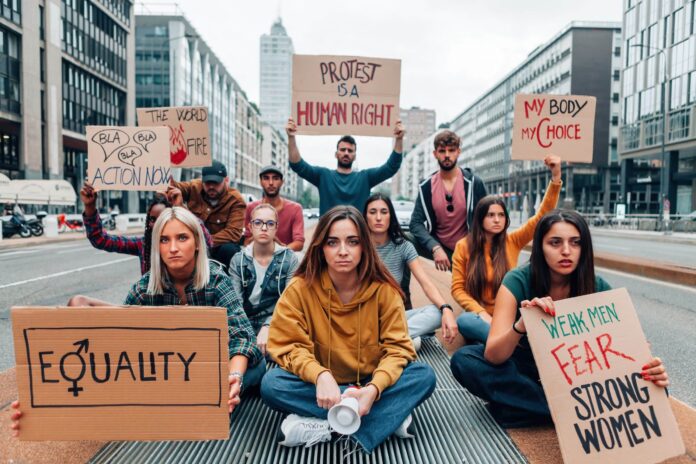The concept of gender equality has been a subject of fervent discussion for decades. The dialogue surrounding the equality of men and women extends beyond simplistic assertions of fairness; it encompasses a comprehensive analysis of various sociocultural, economic, and historical factors that have shaped gender dynamics. To engage in a meaningful debate on the premise that men and women are inherently equal, one must arm themselves with a multifaceted understanding of both the ideological and empirical aspects of gender equality.
Engaging in a debate about gender equality necessitates a predilection for critical thinking. This includes an acknowledgment of intersectionality—the idea that various social categorizations such as race, class, and gender intersect, creating overlapping systems of discrimination or disadvantage. Thus, when advocating for gender equality, it is imperative to consider not just gender as an isolated category, but how it interacts with other societal variables.
Furthermore, the debate requires a meticulous examination of historical context. The evolution of gender roles, norms, and expectations has profoundly impacted perceptions of equality. By delving into historical precedents, one can uncover the roots of contemporary biases and engage more effectively in discussions about equality.
To debate like a professional, one must not only be well-informed but also be passionate about the subject, weaving in personal anecdotes and statistical data to bolster arguments. This presentation will explore critical considerations in debating gender equality, focusing on effective communication strategies, the importance of empathy, and the role of language in shaping discourse.
The foundations of a compelling debate are rooted in effective communication. This entails not only articulating one’s arguments clearly but also actively listening to counterarguments. When debating gender equality, it is essential to approach the subject matter with a balanced perspective, recognizing differing viewpoints while asserting one’s stance.
To initiate constructive dialogue, debaters should employ techniques such as the use of analogies. Analogies create relatable parallels that illuminate complex ideas. For instance, one might liken the pursuit of gender equality to the struggle for civil rights. By drawing connections between different struggles against oppression, the argument for gender equality can be positioned as a continuation of a broader humanitarian effort.
Furthermore, it is important to utilize empirical evidence. Statistics illuminating disparities in education, income, and representation are powerful tools that substantiate claims of inequality. Presenting data, such as the gender pay gap, can provide tangible evidence in support of the assertion that men and women are not afforded equal opportunities.
Nevertheless, the effective debater must also emphasize empathy. This involves recognizing and validating the experiences of others, which fosters an environment conducive to open dialogue. Empathy allows debaters to acknowledge that their interlocutors may have differing life experiences that shape their views on gender roles and equality.
Moreover, how one frames the debate significantly impacts its reception. The language used can either alienate or invite engagement. Framing gender equality as a collective societal goal rather than a zero-sum game can open avenues for collaboration rather than confrontation. Language that emphasizes shared humanity can bridge divides, allowing for a more nuanced discussion about gender dynamics.
In addition to language and communication techniques, understanding the historical context of gender disparities is vital. A thorough examination of women’s rights movements illuminates the progress made and the continuous struggle for equality. An analysis of landmark legislation such as the Title IX of the Education Amendments of 1972 in the United States, which prohibits discrimination on the basis of sex in federally funded education programs, provides insight into systemic changes that have been initiated to address gender disparities.
Examining historical figures in the feminist movement, such as Mary Wollstonecraft and Simone de Beauvoir, offers rich perspectives on the philosophical underpinnings of gender equality. Their works challenge societal norms, advocating for the recognition of women’s rights as human rights. Citing such figures not only lends credibility to the argument but also demonstrates the deep-seated nature of gender equality activism.
Diving into contemporary issues within the debate, intersectionality plays an intrinsic role in discussions about equality. Gender should not be viewed as a monolithic experience; women from different racial backgrounds, socioeconomic statuses, and sexual orientations face unique challenges. An adept debater should consider these intersections, which complicates the narrative and enriches the discourse surrounding gender equality.
Furthermore, the rise of social media as a platform for activism cannot be overlooked. Social networks have become avenues for amplifying voices that challenge patriarchal norms and advocate for gender equality. Engaging with movements such as #MeToo and #TimesUp demonstrates how digital platforms can mobilize collective action and raise awareness of gender-based violence and discrimination.
However, it is crucial to remain vigilant about the potential pitfalls of online discourse. Arguments presented on platforms like Twitter or Facebook can devolve into toxic exchanges that hinder productive dialogue. Therefore, those engaged in debates surrounding gender equality must strive for a tone of respect and understanding, even in the face of disagreement. This self-regulation underscores the importance of civility, particularly when discussing sensitive subjects that evoke strong emotions.
Ultimately, the objective of debating whether men and women are equal should be centered around fostering understanding and advocating for equitable treatment in all spheres of life. The battle for gender equality is not merely a women’s issue; it is a societal issue that involves men and women alike in constructing a more just world. Leveraging personal narratives alongside empirical data creates a compelling case for equality that resonates on various levels.
In conclusion, to debate the equality of men and women like a professional involves not only understanding and articulating the foundational principles of gender equality but also employing strategic communication techniques, historical context, and an empathetic approach. Recognizing the interconnected nature of gender, race, class, and other sociopolitical factors allows for a richer, more nuanced discussion. As society progresses, it becomes increasingly crucial to engage in dialogues that challenge inequitable structures—deploring them in favor of a more inclusive, equitable future for all.





























